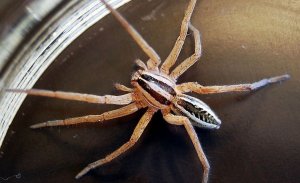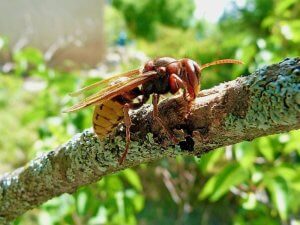Determining the most or best of any particular thing or category can be a relative, sometimes challenging endeavor. When the honor concerns the designation of insects that have the most painful stings, there are no awards or speeches given; there is only the desire to move away as quickly as possible from all the nominees.
They are: bees, ants, wasps and flies, but equally perilous are encounters with angry arachnids, such as spiders and ticks. Knowing the habitats and behaviors of some of the most common insects Pittsburgh residents are likely to encounter, can help avoid confrontation.
There is also comfort in knowing that if these critters invade your home or property, help is always there with the pest-control and pest-management specialists at Pestco Professional Services — (412) 252-5200.

Here are 9 qualifications to look for in a pest control company.
Insect Bites Versus Insect Stings
While it is highly unlikely that anyone feeling the immediate pain of a sting or bite from some unpleasant passing critter will try to decipher immediately whether it is a sting or a bite, as screaming often interferes with sequential thought processes, knowing the difference can be important, especially if follow up treatment is necessary.
Most bites and stings trigger nothing more than minor discomfort, but some encounters can be deadly, especially if the victim has severe allergies to the venom.
Initially, an insect bite can be painful and often an allergic reaction follows from the venom that is injected into the skin via the insect’s mouth or stinger. The reaction is the result of the insect leaving behind their saliva in the bloodstream. Biting bugs include: spiders, mosquitoes, flies and ticks.

Many insects, especially females of the species, seek blood for nutrients like protein and iron, which is a necessity for the production of viable eggs. Insect bites are usually red, swollen and often itchy around the site.
An insect’s sting releases a small amount of toxin into the body, which launches an immune reaction. Remnants of the sting, such as soreness and swelling, tend to remain localized to that specific area. Insect bites can be serious because sometimes they spread serious diseases such as Lyme disease and Rocky Mountain Spotted Fever in ticks, and the West Nile and Zika viruses in mosquitoes.
In addition, some people might not even know they are allergic to insect venom, the result of which can be a life-threatening anaphylactic reaction that requires immediate medical attention.
Danger and Damage To Pittsburgh Residences
Summer is upon us, and that always translates into more time spent enjoying the great outdoors. With the warmer weather and longer days come picnics, sports activities and nasty critters with even nastier stingers, hell-bent on making their painful points.
For those who live in Central Pennsylvania, our experts at Pestco Professional Services are there to help. Our teams are fully aware that some of these stinging pests, notably social wasps, can be a very destructive nuisance in home gardens, nurseries and areas surrounding both residential and commercial properties.

Here are 5 tips to help keep stinging insects off of your Pittsburgh lawn.
What Is The Schmidt Pain Index?
The Schmidt Pain Index was created in 1973 by an entomologist at the Carl Hayden Bee Research Centre in Arizona named Justin O. Schmidt. He and his team made the ultimate sacrifice compiling this list, as they all subjected themselves to experiencing different levels of pain in order to honestly collect and evaluate the necessary data.
Although pain is certainly relative, this index rates each sting or bite on a pain scale of 0-4, with 0 being completely painless to 4, which in Schmidt’s words: ”You don’t want to know. The pain is so immediate and intense that it shuts down all illusions of life as normal. Imagine sticking a finger in a 240-volt electrical socket!”
This unique index also provides information concerning the duration of the pain, which can be useful as well as distracting, especially when a person is very busy screaming.
By 1990, the Schmidt Pain Index covered 78 different insect stings and bites, all with their own ratings and unique descriptions explained in a way everyone can understand. Schmidt subsequently went on to study the chemistry behind the pain caused by insect venom, as well as how and why venom has developed as part of their defense mechanisms.
Stinging Bugs, Ants And Arachnids
The following is a list of some unforgettable critters that may or may not roam the Pittsburgh landscape, but are nevertheless certain to scamper across the netherworld of nightmares.
1. The Tarantula Hawk Wasp
The stinger on this species of spider wasp that preys on tarantulas can be up 7mm or 1/3 to 2/3 of an inch long. Although it only stings when extremely provoked, it is very potent and considered to be one of the most painful in the world. It is rated 4 on the pain index.
The composition of its venom is unknown, which is not very reassuring, and the duration of the sting is about five minutes. The pain is described as: “Torture. You are chained in the flow of an active volcano. Instantaneous, electrifying, excruciating, and totally debilitating. Blinding, fierce, like a running a hair drier has been dropped into your bubble bath.”
2. The Executioner Wasp
Take a wild guess as to how this newly-discovered, nasty critter got its name! There seems little doubt that its sting is the reason, which is enough justification to run when encountering one of these critters along a leafy promenade.
Although their natural habitat is South America and far away from Pittsburgh homeowners, the fact that they even exist is is enough to send a sizable shiver up and down the most secure of spines. The pain, which is rated #2 on the Schmidt scale, is said to be excruciatingly painful and capable of burning a hole at the site of the sting.
3. The Eastern Yellow Jacket
These black-and-yellow wasps nest in the ground and can be found n Pittsburgh lawns,, parks and woodlands. Their painful sting, which is rated at #2, can be life-threatening to those who suffer from allergies and can last for up to 10 minutes.
Our technicians at Pestco Professional Services are often called upon to exterminate these wasps. The character of the pain is described as “hot and smoky, almost irreverent. Imagine W. C. Fields extinguishing a cigar on your tongue.”
4. Bald-Faced Hornet
Rated at pain level #2, these nasty, aggressive and very large hornets are found throughout the United States and other parts of North America. Also known as Giant Asian hornets, they will sting if their nest area, which is usually in hollow cavities or shrubs, is invaded.
They have been known to spray venom into the eyes of their victims. Schmidt describes this pain, which can throb for up to almost 5 minutes before subsiding as: “Similar to getting your hand mashed in a revolving door.”
5. Northern Paper Wasp
There are 300 different species of paper wasps in the world. Of these, 22 are found in the United States. They gather fibers from dead wood and plants, which they mix with saliva to construct water-resistant nests made of gray or brown papery material. They can sting multiple times when their nests are threatened, and the ensuing pain is rated at level#2 on the scale.
The only saving grace is that the pain starts to fade after about 15 minutes. Their venom can cause a severe allergic reaction in some people that requires immediate medical attention.
6. The Red Paper Wasp
If you upset one of these Central and South American wasps, it will release venom into the nest to rally friends to help in chasing you down. Schmidt rated the pain at level #3 and wrote: “Caustic and burning, with a distinctly bitter aftertaste. Like spilling a beaker of hydrochloric acid on a paper cut.”
7. Warrior Wasp
Predominantly found in South and Central America, the Warrior Wasp is very large, more than 2 inches long, with jaws longer than its front legs. The sting is rated at pain level #4, and Schmidt describes it as: “Explosive and long lasting. You sound insane as you scream. Hot oil from the deep fryer spilling over your entire hand.”
8. The Polybia Wasp
This species is found primarily in Brazil, Paraguay, and Argentina. On the pain index scale, it ranks at 2.5. Schmidt describes the sting as: “A ritual gone wrong, satanic. The gas lamp in the old church explodes in your face when you light it.”
9. Western Honeybee
Rated at pain level of 3 on Schmidt’s pain scale, the stinger on the Western honeybee is barbed and located at the end the abdomen. It is tied to the digestive tract, as is the venom sac that produces the venom. When a honey bee stings, its stinger, the venom sac and other parts of the honey bee’s body are pulled out and left behind, killing the bee.
Schmidt describes the pain as:“It’s crawled into your soda can and stings you on the tongue. It’s immediate, noisome, visceral, and debilitating. For ten minutes, life is not worth living.”
10. Sweat Bee
Attracted by human sweat, the females can sting. Once the stinger pierces the skin, it continues to pump venom until you pull it out. Obviously, the best advise is to remove it in between screams as quickly as possible. Pain is instantaneous, sharp, burning, and usually lasts a few seconds. On the Schmidt scale it is rated at level#1 and described as: “feeling light and ephemeral. Almost fruity.”
11. Giant Bornean Carpenter Bee
One of the world’s largest bees with a mouse-size black body and iridescent purple wings, this bee, which is native to Asia is not terribly aggressive. When it does sting, however, the pain is rated a 2.5. Schmidt states: “Electrifying, sharp, and piercing. Next time hire an electrician.”
While many species of spiders call Pennsylvania home (if they could call), the majority of them are not a threat to humans. The following three species, however, have bites that are worthy of honorable mention and if seen merit notifying pest-control and pest-management experts immediately — (412) 252-5200.
12. Sac Spiders
Known to bite without provocation, these spiders hide outdoors under leaves and stones and indoors roam boldly on walls and ceilings. They are nocturnal hunters and their painful bite, which usually lasts for about one hour and 45 minutes, is marked by burning, swelling, itching and necrosis meaning, that the venom damages and kill skin tissue.
13. Wolf Spiders
These large, hairy brown spiders are found across the United States. Although the wolf spider’s bite is not deadly, it can be very painful. It rarely causes any symptoms other than pain and redness. Swelling and pain lasts for only a few days, but is sometimes known to last as many as 10.
14. Brown Recluse Spiders
Although our pest-control and pest-management technicians rarely come across this species in Pittsburgh, some have been accidentally transported to central Pennsylvania via merchandise or produce shipment boxes from other parts of the country.
These small, brown spiders have violin-shaped markings on top of their bodies. While the bite of a brown recluse is not initially painful, 24 hours after being bitten, the pain is described as a “throbbing fire.” These bites often require medical attention.
Ants
While anyone who has ever been to picnic is familiar with ants ruining the day, how many have been bitten by one of them and lived to tell the tale? Each species of ant brings its own unique level of pain to the Schmidt pain scale that ranges from the mild snap of the fire ant to the excruciating agony of the bullet ant. These tiny creatures are not to be messed with.
15. The Bullet Ant
Rated at the very top of Schmidt’s list with a: 4.0+, this South American rain forest critter isn’t likely to sting a Pittsburgh home owner lounging in a backyard, but it is nevertheless, an entity to reckon with, if only in the world of too many martinis and bad dreams. The sting is described as being like “walking over flaming charcoal with a 3 inch rusty nail in your heel.” The pain can last from 12 to 24 hours.
16. Bullhorn Acacia Ant
These arboreal, wasp-like ants are known for their orange-brown bodies and very large eyes. Their natural habitat is Central America where they are best known and named for living in symbiosis with the bullhorn acacia plant. Their sting is rated at 1.8 and the pain is known to last from 4 to 6 minutes. Schmidt describes it as: “rare, piercing and elevating, like someone has fired a staple into your cheek.”
17. The Red Harvester Ant
Typically found in New Mexico and Arizona, the sting from these ants can inflame nerves for up to 8 hours and the pain is rated a 3.0 on the Schmidt Index. The discomfort is “bold, and unrelenting. Somebody is using a drill to excavate your ingrown toenail.”
18. The Maricopa Harvester Ant
Found throughout much of the western United States. and Mexico, one 1996 University of Florida study cited this species as having the most toxic insect venom in the world—about 20 times stronger than that of a honey bee.
A sting produces intense, long-lasting misery that is at pain level #3 and according to Schmidt: “After eight unrelenting hours of drilling into that ingrown toenail, you find the drill is wedged in the toe.”
19. The Velvet Ant
Also known as “The Cow Killer,” North American Velvet ants are actually wingless female wasps, and their fearsome stinger (the longest, relative to body size, of any stinging insect in the world) is just one of its many defense mechanisms. Cow-killer venom causes intense agony and its pain is rated at level #3.
20. Giant Desert Centipede
The giant desert centipede doesn’t actually bite. Instead it pinches from a pair of modified hollow legs located near the insect’s head. The pinch injects venom that causes intense pain. Schmidt estimates the pain to be at the top of his pain scale index although he has never experienced it himself. He states: ”Centipede bites produce a burning pain that hurts for a long time. People are usually whining and limping around a good 12 hours later.”
In Conclusion
Although far from reassuring, if nothing else, this list will make Pittsburgh residents glad they don’t live in places where many of these unpleasant critters reside. Still, one never knows, and our teams have been on the job for more than seven decades eradicating unwanted pests from residential and commercial spaces using our own sustainable line of products.
Call us today! We’re here to help! +1-412-252-5200

Image Credits: Pixabay
 Over 300 Reviews
Over 300 Reviews 